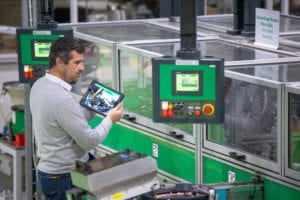Artificial intelligence (AI) is poised to dramatically increase productivity and profitability for commercial and industrial companies by automating responses to events in real time – if companies have the appropriate industrial edge infrastructure on site to deliver the performance the technology requires.
AI technologies such as robotic process automation (RPA) make it possible to free up humans from repetitive tasks and instead have them focus on more strategic endeavors. RPA can process vast amounts of data in milliseconds, setting the stage for applications ranging from predictive maintenance to streamlined, digitized production and financial processes.
But to be effective, RPA must have access to significant compute resources. And given the real-time nature of the applications in industrial and commercial environments, those compute resources must be local, not in some faraway data center or in the cloud. In short, RPA demands edge computing, which means commercial and industrial companies need to explore ways to effectively deliver edge data centers to all the sites that need them – potentially dozens or hundreds of them for verticals such as retail.
What RPA is and how it works
RPA is ideally suited for dealing with the vast quantities of data resulting from Industry 4.0, which involves the digitization of all sorts of applications and processes in verticals ranging from manufacturing to retail and healthcare.
As its name implies, RPA automates repetitive processes. The way it works is RPA software essentially records the steps a human takes to perform a given function, then has a computer perform those same steps – over and over, just much faster and with more accuracy than a human can.
Any process that involves doing the exact same thing over and over is ripe for automation with RPA. It can apply to order fulfillment, responding to customer emails, handing inventory reports and bills of materials, aiding with regulatory compliance and lots more.
Consider predictive maintenance in an industrial setting. A given machine generates a constant stream of data reporting on its status. Normally, a human would look at that data and try to identify variations from a normal baseline status. Probably, he’d be looking at a chart after the fact, not in real time – because humans just can’t keep up.
RPA automates the task and reads the data in real time, raising a flag only when a variation is identified, at which point a human can step in and determine whether it’s an issue that requires addressing. Not only does the company get machine status data more quickly, but it frees up the human to do more strategic (and interesting) work, delivering added value to the organization.
The same technology can be used in all sorts of applications, such as to help with production. An RPA application could be used to perform input and output checks on raw materials, to determine what materials are needed, and when. RPA can also be used to track production hours and materials used, to help predict the final cost of goods. Importantly, it also dramatically reduces the possibility of human error.
RPA requires industrial edge infrastructure
All of these applications happen in real-time, and thus require low latency computing, driving the need for edge data centers.
Edge data center requirements are much the same as those in a traditional data center, including robust compute, storage and network resources as well as sound physical and cyber security. But it all has to be delivered in a much smaller package.
That’s where micro data centers come in. They come in various form factors but generally are self-enclosed units that include all the required power, cooling and power protection infrastructure. Customers can get them configured with the exact compute, storage and network technology they want, following reference architectures that ensure it’ll all work well together. And micro data centers can be configured either in the factory or by a systems integrator, so they’re ready to go when delivered on site. That reduces time to value and is also an important consideration when there are no IT resources on site.
Many micro data center options – and partners
Schneider Electric, of course, has a range of micro data center solutions to choose from, whether you need something that can handle a harsh outdoor or plant floor environment or one that blends nicely into a retail establishment. We also have relationships with a number of alliance partners, whose compute, storage and networking infrastructure are all certified to work seamlessly in our micro data center enclosures. Put it all together and you’ll have everything you need to make AI and RPA pay off for your organization. For more information on our Commercial and Industrial solutions, please visit our industrial business continuity site.



